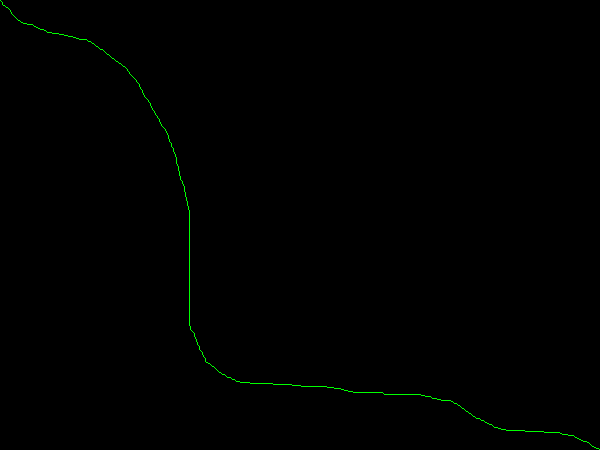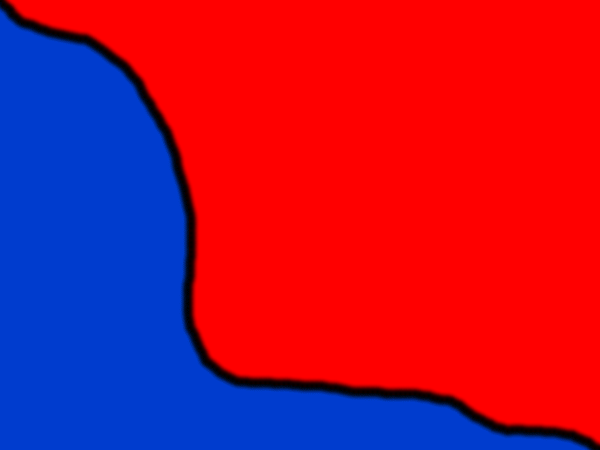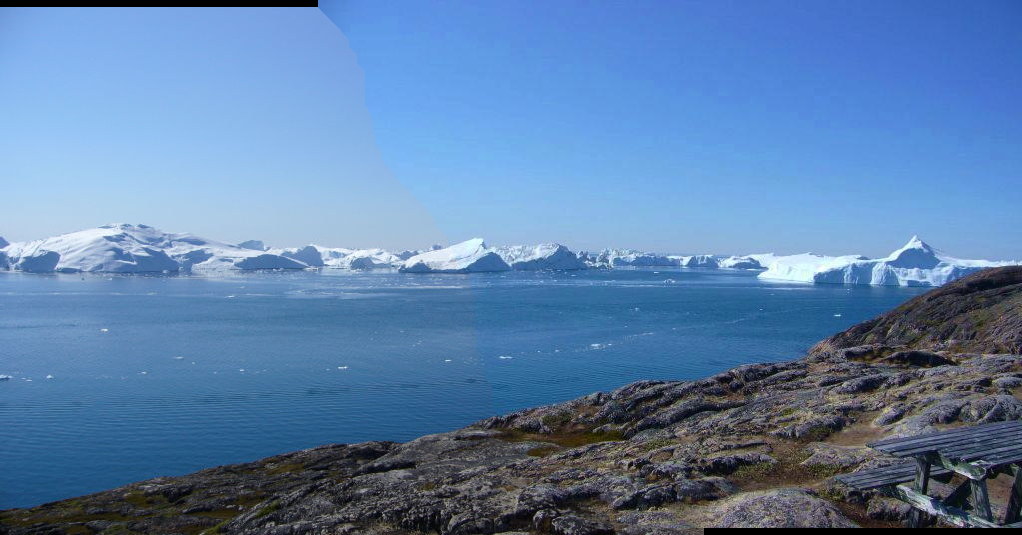A. Goals
The purpose of the Edit Distance assignments is to synthesize everything that you learned in the course. The specific goals of Part II are to:
- Learn about computational photography
- Work with images
- Use external libraries and understand how to use API documentation
At the end of this assignment, you will have created a new application of
CostMatrix.java from Part I
to stitch two images together along a least visible seam.
This is an algorithm used often in digital photography.
B. End-of-semester evaluation
Thank you for joining us this semester in CIS 110. We would like to ask you
to fill out an
C. Your program
In Part I of the Edit Distance assignment, you wrote
the CostMatrix class to generate optimal string alignments.
In Part II, you will use the same CostMatrix
class to find least visible seams across two images.
You will write an ImageSeam class that contains two
Picture objects for which CostMatrix can compute the minimum-cost seam.
Below is the API:
public class ImageSeam implements Matchable
-------------------------------------------
public ImageSeam(Picture left, Picture right) // constructs an ImageSeam object with
// the Picture objects left, right where left
// and right are of the same size
public ImageSeam(String left, String right) // constructs an ImageSeam object with
// the images at filenames left, right
// where left and right are of the same size
public int height() // returns the height of left
public int width() // returns the width of left
public int matchCost(int row, int col, char direction) // returns the squared color difference
// between the pixels at (row, col) of left
// and right
public void showSeam(Path p) // displays the seam represented by the
// Path object p
public Picture getStitchedPicture(Path p) // returns a new Picture with left and
// right stitched along the seam p
As a reminder, we repeat the APIs for CostMatrix and Path.
public class CostMatrix
-----------------------
public static Path costRecursive(Matchable m) // computes the minimum-cost alignment
// recursively and returns a linked list
// of Path objects representing the
// minimum-cost alignment
public static Path costIterative(Matchable m) // computes the minimum-cost alignment
// iteratively and returns a linked list
// of Path objects representing the
// minimum-cost alignment
public class Path
-----------------
public Path(int row, int col, int cost, Path next) // constructs a Path object that represents
// the cost of matching
// the Matchable objects at (row, col); next
// points to the Path object
// that provided the minimum cost for this match
In addition, we provide a client program Stitcher.java
that preprocesses the images to stitch only the overlapping areas.
D. Getting started
Download Stitcher.java.
You may also
need Picture.java,
although the introcs installer should have set it up for you
already.
Because this assignment depends upon hw09: Edit Distance,
you will need to copy the following files into your
directory for this
assignment: CostMatrix.java, Path.java,
and Matchable.java. If you have
implemented CostMatrix.java correctly in hw09,
you should not need to make any changes to these files for
this assignment to work.
You will submit CostMatrix.java to run our
tests for the ImageSeam.java class. You are
welcome to update CostMatrix.java to correct
bugs in CostMatrix.costIterative() and add tests, but
you shouldn't need to if it is already working
properly. You will not be graded for style on
your CostMatrix.java code.
Nevertheless, your CostMatrix class must compile, and
your CostMatrix.costIterative() function
should be correct, for all of our tests to pass; otherwise, you may
lose points. (We will not
use CostMatrix.costRecursive() for any of our grading
on this assignment, so it does not matter if your recursive implementation doesn't
work.) Your CostMatrix class must also be your own work, and you must record
any help or outside resources in you help log as usual.
You will not submit EditDistance.java. If you used your
EditDistance class to test CostMatrix, you can leave
any references to EditDistance in your CostMatrix.main(),
since we will compile your CostMatrix with a "dummy"
EditDistance class on the server.
This assignment was created by Benedict Brown. It was adapted by Arvind Bhusnurmath, Max Tromanhauser, Neera Thavornvanit, and Scott Wang.
ImageSeamA. Image stitching
Combining multiple images into a larger panorama is one of the oldest techniques in the field of computational photography, which combines computer algorithms with traditional photography to create images that are difficult or impossible to achieve purely with optical lenses. Camera lenses have a much narrower field of view than human vision, so a single photograph cannot capture an entire landscape as you see it. Panoramic stitching solves the problem by taking two overlapping images and "stitching" them together along a "least visible seam" into a single, large image, where the pixels to the left of that seam are taken from the left-hand image, and the pixels to the right are taken from the right-hand image. As long as the two images are nearly identical along the least visible seam, the seam will only be barely visible in the final image.
We restrict our image stitching implementation to seams that run down, right, or diagonally. This means that finding the least visible seam uses the same type of cost optimization as sequence alignment.
B. The ImageSeam class and the Picture and Color
libraries
You will write an ImageSeam class that provides the
methods necessary to allow CostMatrix to find the least
visible seam.
The ImageSeam class implements the Matchable
interface from hw09. Write the skeleton of the ImageSeam
class according to the API in Section 0B, making sure that it implements
the Matchable interface.
The textbook's standard library, which was installed by the
introcs installer you ran in hw00, provides
a Picture class. The API documentation
for Picture
is here.
In addition, because you will be working with
Color values, you will need to include
the java.awt.Color library in
your ImageSeam class by including the statement
import java.awt.Color;
at the top of ImageSeam.java, before your class
declaration. The booksite's documentation
for java.awt.Color (which is actually built into
Java) is
here.
C. Methods and constructors for ImageSeam
When implementing the following methods, refer to the API
documentation for Picture.
ImageSeam(Picture left, Picture right)
constructs the ImageSeam object with the two Pictures
left and right. If
either left or right
is null, or if the dimensions of right
are different from those of left,
then ImageSeam() should throw
an IllegalArgumentException.
Your class must not modify left or right in any way.
ImageSeam(String left, String right)
constructs the ImageSeam object with the images given by filenames
left and right. If either left or right
is null, then ImageSeam() should throw an IllegalArgumentException.
Avoid duplicating code between the ImageSeam(Picture, Picture) and ImageSeam(String, String)
constructors.
height() returns the height of left (which is equal to the
height of right, as enforced by the constructors).
width() returns the width of left (which is equal to the
width of right, as enforced by the constructors).
D. ImageSeam.matchCost()
The least visible seam passes through the locations where the pixel colors are as close as possible
between left and right.
Therefore, the cost of stitching left and right
along a seam passing through a pixel (row, col)
will be the difference in color between the (row, col) pixel of left
and the (row, col) pixel of right.
Because a pixel's color is comprised of red, green, and blue
components, we will quantify the "difference in color" between
the (row, col) pixels of left
and right using this expression, called the squared
pixel difference: (rL
- rR)2 +
(gL - gR)2
+ (bL
- bR)2,
where rL is the red value
of left's pixel (row, col),
rR is the red value of the
right's pixel (row, col), etc.
matchCost(int row, int col, char direction)
returns the squared pixel difference between the (row, col) pixels
of left and right. The direction argument is ignored,
but your matchCost() should check for invalid parameter values and throw
IllegalArgumentException.
Refer to the API documentation for Picture and
Color to implement this method.
You should use the getRed(), getGreen(), and getBlue()
methods of the Color object.
Be careful: we have written the pixel coordinates
above in the order (row, col), but the
order of arguments for the pixel methods
of Picture is specified as (x, y),
which is actually (col, row).
Variable name change – We have renamed
the i and j variables from the Edit
Distance assignment to row and col,
which are less confusing. You do not need to
update Matchable.java even though it still lists
the matchCost parameters as i
and j; just name the parameters of
the matchCost function
in ImageSeam.java row
and col. To maintain compatibility with Edit
Distance, Path.java cannot change and will
still refer to i and j. If you get
confused, just refer to this table:
Path | ImageSeam |
|---|---|
i | row |
j | col |
E. Checkpoint
Write tests in ImageSeam.main() to test the functionality of the ImageSeam class.
Save the images example-blue.png and example-red.png.
Construct an ImageSeam object with these images, and pass it into
CostMatrix.costIterative(). The cost of the resulting Path should be 129211.
showSeam() and
getStitchedPicture()We will now write utility methods to display the location of a seam, and stitch
left and right into one new Picture.
A. ImageSeam.showSeam()
showSeam(Path p) should display the location of the pixels
on the seam:
- Construct a new, blank
Picture - Iterate through the seam
pand change the color of each pixel inpto a different color (say, white) - Display the resulting
Picture
Refer to the API for Picture to find the correct method calls.
You should check whether the Path
is null and throw a RuntimeException
if so.
However, you may assume that the cost values and pixel
coordinates in p represent a valid
seam.
Warning – Do not
call Picture.save(). Doing so will break our test
scripts, and you will receive a large point deduction.
B. ImageSeam.getStitchedPicture()
getStitchedPicture(Path p) should return a new
Picture that stitches left
and right, where the areas of left
and right are overlapping. Pixels to the left of
the seam and on the seam adopt the pixel colors
of left; pixels to the right of the seam adopt the
pixel colors of right.
- Construct a new, blank
Picture pic - Iterate through each pixel (
row,col) inpand change the color of each pixel inpicto the left of (row,col), including (row,col), to the corresponding pixel color ofleft, and the color of each pixel to the right of (row,col) to the corresponding pixel color ofright - Return
pic
You should check whether the Path is null
and throw a RuntimeException if so.
However, you may assume that the cost values and pixel
coordinates in p represent a
valid seam.
Reminder – The i instance variable
of each Path object corresponds to
the row. The j instance variable
corresponds to the col.
Warning – Do not call Picture.save(). Doing so will break our
test scripts, and you will receive a large point deduction.
C. Checkpoint
Write tests in ImageSeam.main() to test the functionality of the
showSeam() and getStitchedPicture() methods.
Construct an ImageSeam object
with example-blue.png
and example-red.png. The result you should obtain
by calling showSeam() with the path
from CostMatrix.costIterative() is shown below.

Download
example-stitched.png – it is the image that
you should obtain on
calling getStitchedPicture().

StitcherA. Partially overlapping images
The getStitchedPicture() method
of ImageSeam assumes that the stitching area
overlaps completely between left
and right and that the seam runs from the top
left to the bottom right. The more common case is where the
image stitching areas overlap only partially, and where the
seam may be running in a different direction. To stitch such
images together, we can specify the overlapping portion and
the seam direction, and create an ImageSeam
object with only this overlapping portion, flipping this image
horizontally or vertically such that the seam always runs from
the top left to the bottom right.
Figuring out how to crop out the overlapping portions of the
images and flip them so the seam runs from the top left to the
bottom right is tedious and involves a lot of trial and
error. Instead, we provide the
program Stitcher.java to do this cropping and
stitching for you. It finds the overlapping portions of the
two images, flips them so that the seam runs from the top left
to the bottom right, uses an ImageSeam object to
find the least visible seam for the overlapping portion, and
embeds the stitched overlapping portion into the combined
panorama.
B. Stitcher
Read the header comment for Stitcher.java to
learn how to use it. To use it, you specify the two input
images and the shift of the second image relative to the first
image. Positive numbers for the shift coordinates shift the
second image right and down; negative numbers shift it left
and up.
Stitcher.java also allows you to specify a
reference image; the pixels that differ between the stitched
image and the reference image will be colored black. (Because
of the possibility of multiple seams with the same total cost,
there may still be some black pixels even if your program is
correct.)
Download the images sea1.png,
sea2.png,
and sea-stitched.png.
Try running the following commands to test your program:
% java Stitcher example-blue.png example-red.png 0 0 % java Stitcher example-blue.png example-red.png 0 0 example-stitched.png % java Stitcher sea1.png sea2.png 318 -7 % java Stitcher sea1.png sea2.png 318 -7 sea-stitched.png
The stitched images should look like the following:

A. Readme
Complete readme_imagestitching.txt in the same way that you have done for previous assignments.
B. Submission
Submit ImageSeam.java, CostMatrix.java, and readme_imagestitching.txt on the course website.
C. End-of-semester evaluation
If you have not yet filled out the